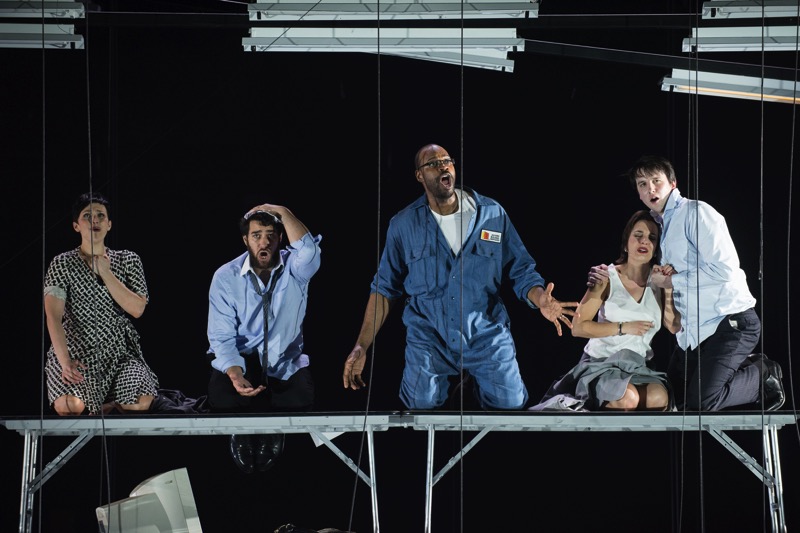Between Worlds, English National Opera, ENO, Barbican, April 2015
Posted on 14 April 2015This opera, ostensibly about the attacks on the World Trade Center on September 11, 2001, is really about what happens when people are suddenly caught between life and death, with only a tenuous connection to their loved ones in the world outside.

Three levels: all images ENO/ Hugo Glendinning
This is reflected in Michael Levine’s set design for Deborah Warner’s production. The focus of the opera — four people and an all-wise janitor who plays the role of ferryman taking them across the waters of death — appear in the mid-level of a three level set. At the top is a man in dark suit and tie (counter-tenor Andrew Watts), who sings, chants, whistles and even shakes a rattle. He is the Shaman. At the bottom level we see the four participants taking leave of their loved ones before attending a meeting on a high floor of the north tower: a young man (William Morgan) who has failed to call his mother (Susan Bickley); a realtor (Clare Presland) who failed to kiss her young son goodbye and left her cell phone at home; a middle-aged man (Phillip Rhodes) who told his wife he was going to a medical appointment; and a young woman (Rhian Lois) who takes leave of her lesbian lover. Also at ground level are the chorus, along with brief appearances by the fire brigade and a security guard.

Janitor and four souls on their way to the afterlife
The music by Tansy Davies, well conducted by Gerry Cornelius, emerged as it were from a world free of time, yielding a sense of mystery but lacking forward movement and a characterisation of the people involved. As such it lacked drama, and without surtitles it is difficult to comment on the libretto by Nick Drake, except when the diction made it particularly clear, such as “What the f**k” by Philip Rhodes, and “There’s never enough time!” by Clare Presland. The main depth of the libretto was expressed in the wonderful diction and singing of Eric Greene as the janitor, but the words needed a more poetic flavour.
Fine singing from the other four main characters, particularly Rhian Lois and Clare Presland, plus Susan Bickley in the relatively minor role of the young man’s mother. With costumes by Brigitte Reiffenstuel, lighting by Jean Kalman, and choreography by Kim Brandstrup this Deborah Warner production had a brilliant team behind it, but the union of music, singing and staging seemed less than the sum of its parts, and left me unmoved.
On a personal note, when the first plane hit the south tower I was in a breakfast meeting in Chicago (one hour behind New York time). As the meeting ended someone shocked us with what was happening, saying the second tower has just been hit. Later that day the phone calls came in, “Can you call Peter in New York, we can’t get a line there from England”. I read the New York Times every day and the stories of loss, heroism and rescue came thick and fast. People running and not stopping until they got home, a few souls who literally cut their way out of a trapped elevator. The terror and tragedy of those days are hard to capture in an opera, which is probably why no one has really tried to, and presumably the reason Ms Davies has turned this into a meditation on life and death.
Performances continue on alternate days until April 25 — for details click here.

